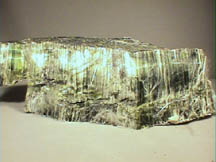Serpentine
"Serpentine helps one understand that gentleness can be strength..."
 The name serpentine comes from both the serpent like patterns on the stone and the belief that the stones were protection from or curative for snake bites.
The name serpentine comes from both the serpent like patterns on the stone and the belief that the stones were protection from or curative for snake bites.
The colors range from white to gray, yellow to green and brown to black and have splotches.
The kinds of serpentine usually used in jewelry are bowenite (translucent green or blue-green) and the rarer williamsite (translucent, oily green, veined or spotted with inclusions).
Serpentine is found in nearly all mountain ranges throughout the world, it is one of the most readily available and easily carved of all stones. Current supplies often come from New Caledonia, Quebec, Northern California, Afganistan, UK, France, Norway, Italy, and Greece.
The ancient Assyrians carried serpentine stone seals so their deities would send double blessings. The ancient Egyptians called Serpentine "meh" and it was often used in amulets. Snakebite protection folklore comes up in several cultures: because of it's mottled appearance that resembles snakeskin, Italian "Streghe" use small pebbles of serpentine to draw out toxin.
The American Zuni people use serpentine for fetish carving.
Serpentine is sometimes used to imitate jade, begin called "Korean jade", "Suzhou jade", "Styrian jade", and "New jade".
Magically, serpentine is used as protection against poisonous creatures, in meditation, especially for Heart chakra and is thought to bring peace and calm amidst turbulent times. It is also used to open the Kundalini energy of root chakra.
The energy of serpentine is magnetic; planets are Venus, Neptune/Pisces. ITs magical number is 8.
For healing, serpentine is worn as an amulet and has been used by nursing women to regulate the milk supply. It is reputed to benefit asthma, hepatitis. It is considered a balancing stone and overall healer.
It was in the 19th century that people
became aware of the fire resistant nature of serpentine, as a result
is was utilized in many materials and fabrics. According to
legend, Romans used this stone as protection against sorcery and the
dark arts. Vessels were made of serpentine, as they were said to
shatter is they came into contact with poison. Therefore, many
ancients began using serpentine to craft drinking vessels.
In the ancient civilizations of America,
serpentine was considered as a guardian of vital energy as well as a
protector of the soul against invisible powers.
In the Middle Ages, serpentine was used
to house medicine as it was told to increase the healing powers of
the medicine and to make it last longer.
Can serpentine cause earthquakes?
"There have been many theories about why the San Andreas Fault slides along so easily, none of which could be tested directly until now."
Zoback said the correlation between the occurrence of serpentine, a metamorphosed remnant of old oceanic crust, and the slippery nature of the fault motion in the area has been the subject of speculation for more than 40 years.
Then, in 2005, when the SAFOD drill pierced the zone of active faulting using rotary drilling (which grinds up the rock into tiny fragments), mineralogist Diane Moore of the USGS detected talc in the rock cuttings brought up to the surface.
"Talc is one of the slipperiest, weakest
minerals ever studied," Hickman said.
Might the same mineral that helps keep a baby's bottom smooth also
be smoothing the way for the huge tectonic plates?
"Serpentine can dissolve in ground water
as fault particles grind past each other and then crystallize in
nearby open pore spaces, allowing the fault to creep even under very
little pressure."
Drilling into the fault lines yielded an
8-foot-long section of very fine-grained powder called fault gouge.
Such gouge is common in fault zones and is produced by the grinding
of rock against rock. "What is remarkable about this gouge is that
it contains abundant fragments of serpentine that appear to have
been swept up into the gouge from the adjacent solid rock," Hickman
said. "The serpentine is floating around in the fault gouge like
raisins in raisin pudding."
Serpentine creates an opening for a
Kundalini awakening to take place. It can also help ease any
discomforts associated with this awakening process because of its
grounding properties.
I find it interesting that this stone can
facilitate awakening of Kundalini energy, which leads to ecstasy
(that which cannot be captured) and that, might also cause
earthquakes!! It is a known fact that Kundalini energy needs
to be awakened properly or there can be quite adverse affects...
earthquakes?
http://www.enn.com/ecosystems/article/23783
http://www.shimmerlings.com/gemstones/serpentine.htm
http://healing.about.com/od/gemstonesaz/p/p_serpentine.htm